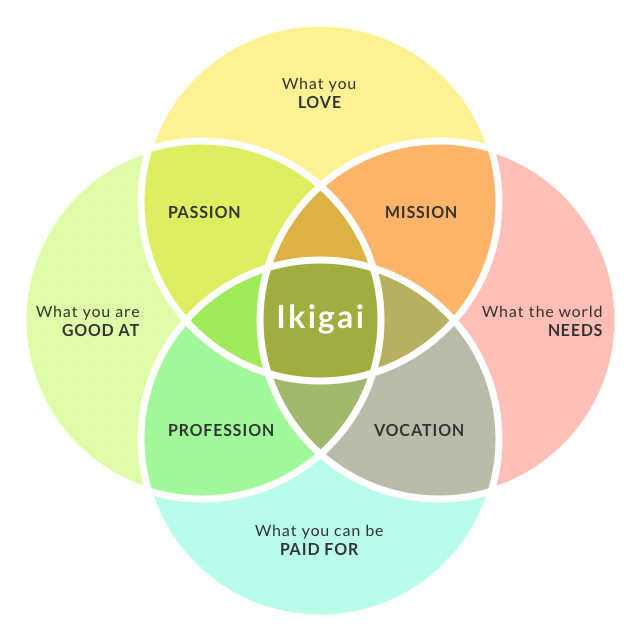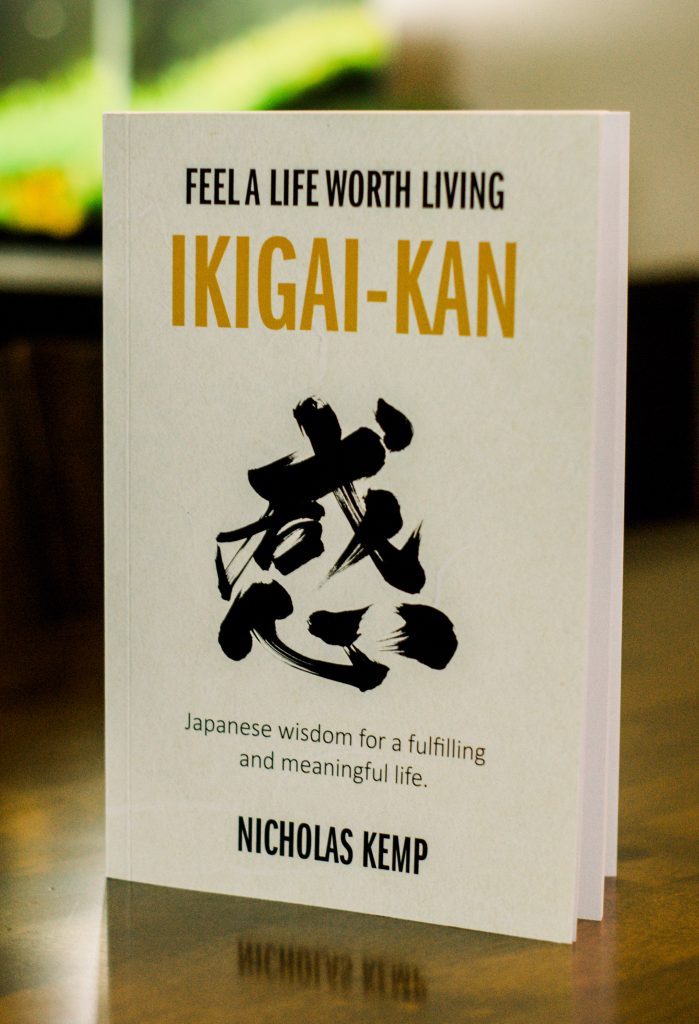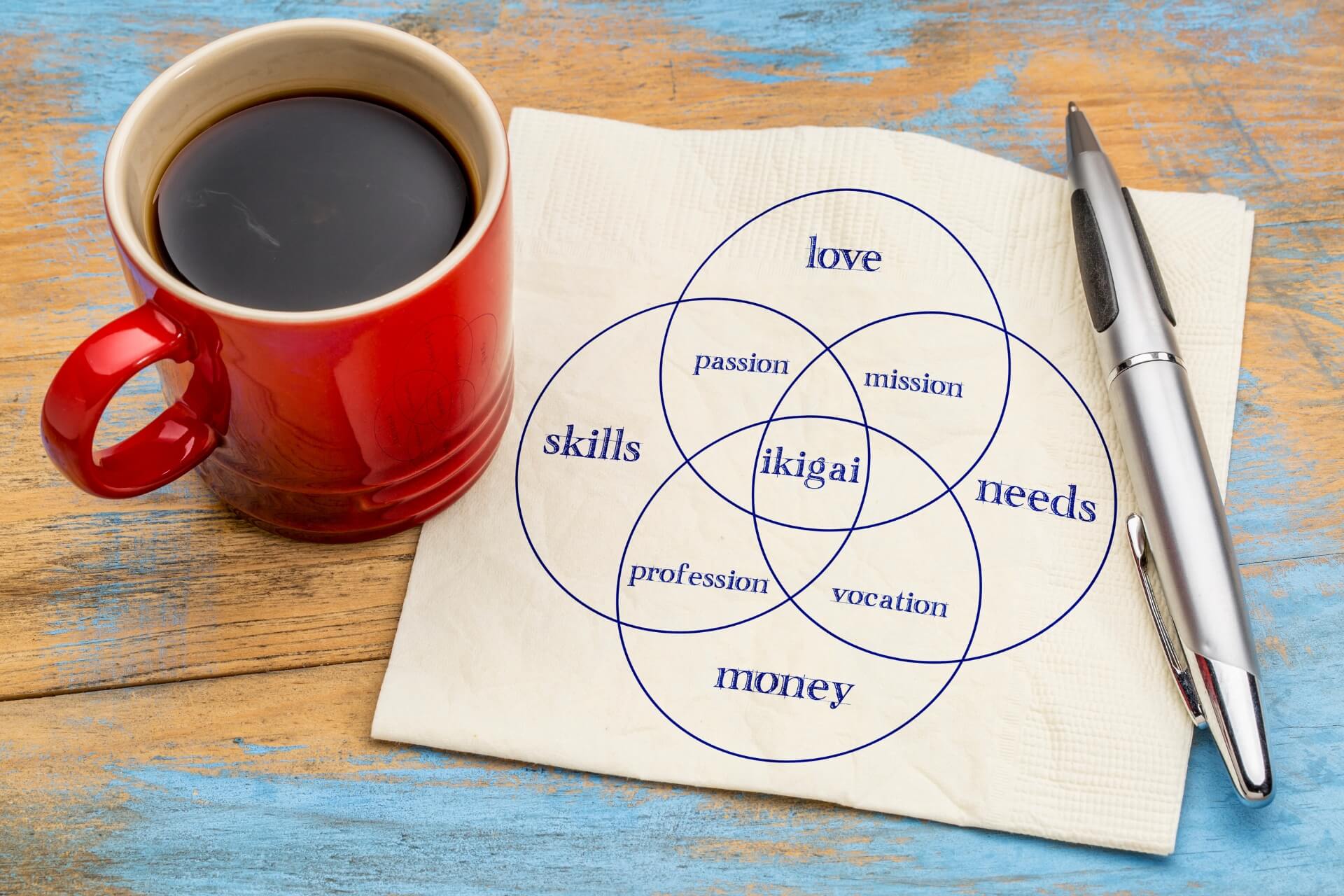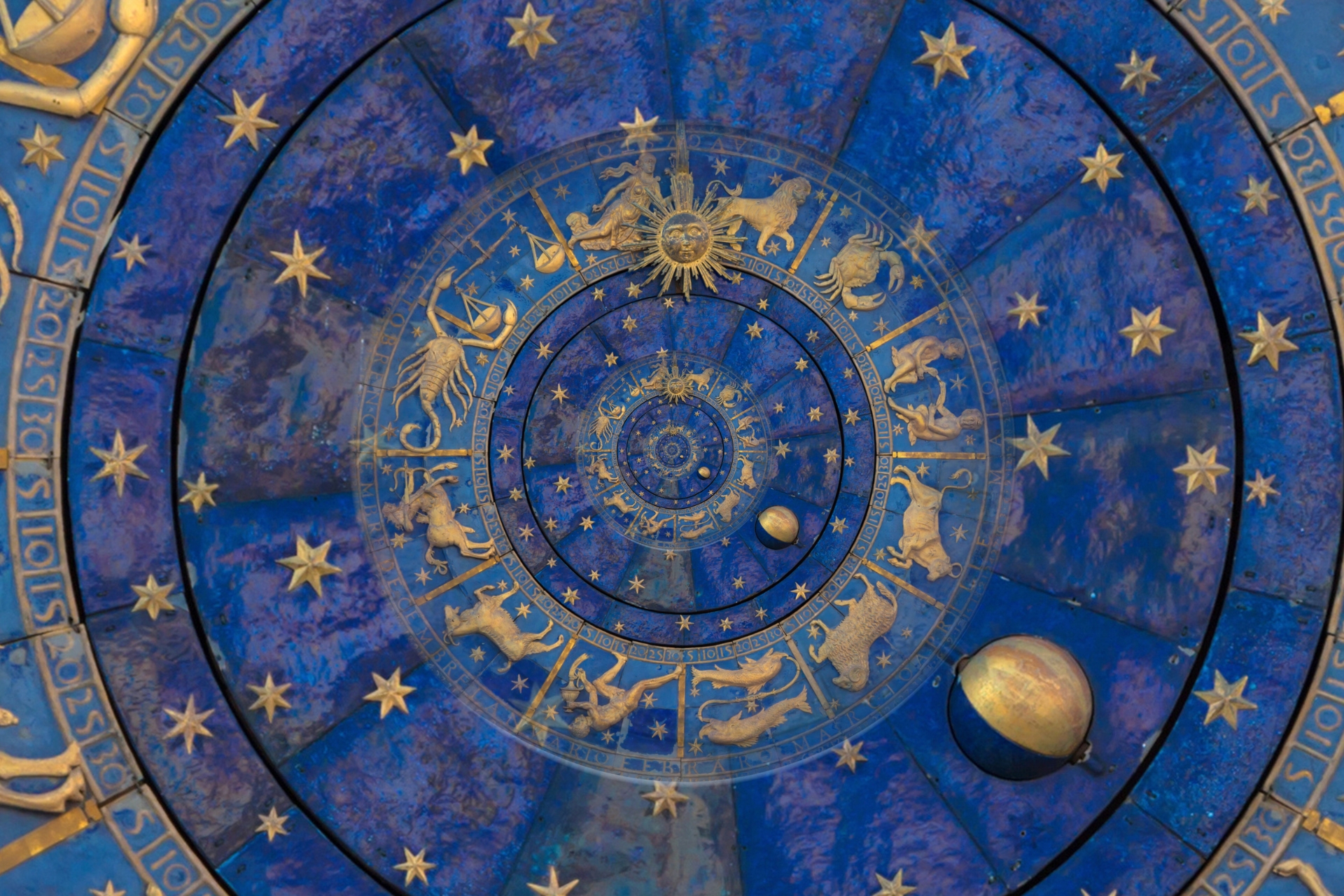by Anjla
Founder of Wysdomly
But did you know that the ikigai diagram fails to depict the authentic meaning of ikigai?

My friend recently shared how she was using the “ikigai diagram” to discover her passions – and get paid for it. She explained how, by answering four questions, she could discover her “ikigai” in the intersection of the circles in the Venn diagram.
- What do you love doing?
- What is it that the world needs?
- What are you good at?
- What can you be paid for?
Clearly a useful tool to ideate a side-hustle, I was more curious about what ikigai meant in its native Japanese context. I suspected the diagram depicted a Western mistranslation or creative re-use of the word, rather than a genuine self-discovery process used in Japan.
As the founder of Wysdomly, and a British Indian, it’s important to me that we strike a balance between sharing wisdom from other cultures and traditions, with the effort to understand that wisdom in its authentic context; as much as is possible with cultural and language barriers.
Colonisation, globalisation, the internet and social media have all contributed to the spread of misunderstood and misinterpreted ideas, concepts, practices and philosophies from different cultures. And often the insensitive – occasionally disrespectful – adoption or perversion of elements from a different culture, even though unintentional.
Ikigai Misunderstood by Nicholas Kemp
As I delved into the provenance of the term, I came across a hugely insightful piece by Nicholas Kemp titled ‘Ikigai Misunderstood and the Origin of the Ikigai Venn Diagram,’ and which forms the basis of this article.
Nicholas Kemp is a Japanologist, author, host of The Ikigai Podcast, and founder of Ikigai Tribe, a group of coaches, teachers, psychologists and university professors who serve their personal community using the ikigai concept. Married to his Japanese wife and with a young son, he lived in Japan for 10 years and has a deep fascination for, and appreciation of Japanese culture.
Kemp is also author of the book IKIGAI-KAN: Feel a Life Worth Living, which he refers to as his ‘dissertation’ on ikigai. He wrote the book by interviewing many Japanese and non-Japanese ikigai researchers to gain accurate insights into the concept, as well as reading many Japanese ikigai studies and research papers.
Of his inspiration to write the book, he says:
One of my personal goals in writing this book is to return this beautiful concept back to its original cultural context and move readers, who are familiar with or use the Venn diagram, from cultural appropriation to cultural appreciation.
Nicholas Kemp

His goal is well-grounded, as I discovered after researching the term. A quick Google search for ikigai will reveal countless coaching courses and books to teach and learn ikigai based on the ikigai diagram. In addition, innumerable articles including from Forbes and the World Economic Forum, discussing ikigai in terms of entrepreneurship and career choices.
In fact, the Japanese do not follow this model or even ask themselves these four questions to discover their ikigai.
Like many other Eastern-based ideas and concepts, ikigai has been adapted, reinterpreted and lost in translation with its spread across the internet. Kemp claims that ikigai is “Japan’s most culturally appropriated and misunderstood concept,” perpetuated by Westerners. He states that the true meaning of the term “contradicts most of the content found on the web and best-selling books.”
So what is ikigai?
While no one, including Kemp, disputes that the ikigai diagram is a useful tool for identifying one’s life passions – especially in relation to entrepreneurship and career choices – it does not accurately represent the Japanese concept of ikigai. You will not discover your ikigai in its true sense at the intersection of these circles.
The ikigai concept is more subtle and complex, deeply ingrained in Japanese culture and psyche; it is based on the notion that one can realise their ikigai by engaging in meaningful and enjoyable activities.
Ikigai (生き甲斐), is translated as meaning the ‘reason for being’. According to Ken Mogi, a neuroscientist, Japanese ikigai expert and bestselling author of The Little Book of Ikigai, ikigai is an ancient and common Japanese concept that can be translated as “a reason to get up in the morning” or “waking up to joy.”
It is realised through the exploration of personally meaningful experiences, rather than asking the four questions in the diagram to discover a single purpose. It could be any number of activities like spending time with your child, the ritual of having your morning coffee, or engaging in your favourite pastime. It can also be the sense of achievement one feels from growing beyond personal challenges.
It’s about the little things. Even the small things you like to do are more important than looking for one grand purpose in life.
A person’s ikigai(s) are the things they put effort into, not for money, but because it matters to them and brings them joy. It’s the process of actively engaging in these activities in daily life.
As Kemp explains, “ikigai is something you feel, not chase or earn… ikigai is a spectrum of all your past, present, and future experiences in your life that have been, are, and will be worth living for.“
This may be difficult for our Western minds to fully comprehend. We are conditioned to seek out happiness, success and meaning in the world. To take action to achieve our goals.
None of these are fundamentally flawed; however, they make it more challenging to comprehend concepts such as ikigai that are not inherent to our way of being and living.
Ikigai is not a matter of chasing success in the world. It is best understood as a process of self-discovery and unfoldment, recognising the activities and experiences that bring joy in your daily life. Happiness for its own sake, rather than as a means of making money.
Kemp explains that “the misconception being perpetuated is that one can only achieve ikigai and true happiness by meeting all four conditions, so if you are doing something you love, but it isn’t generating you money, then you haven’t achieved ikigai – this is false.”
He further quotes Ken Mogi : “Japanese do not need grandiose motivational frameworks to keep going, but rely more on the little rituals in their daily routines.”
Ikigai is not…
In his article, ‘Ikigai Misunderstood and the Origin of the Ikigai Venn Diagram,’ Kemp outlines what ikigai is not:
“It’s not about making money.
It is not the pursuit of professional success or financial freedom. Most Japanese would not associate making money with ikigai.
Success and the accumulation of wealth could be a by-product of your ikigai, but it would not be the focus.
“It’s not what the world needs from you.
Ikigai is not about what the world needs from you. Ikigai lies in the realm of community, family, friendships and in the roles you fulfil.
When you pursue your ikigai, you are not out to save the world. It is more about connecting with and helping the people who give meaning to your life – your family, friends, co-workers and community.
“It’s not about what you’re good at.
You don’t have to be good at something to find your ikigai. Ikigai can be a very simple daily ritual or the practice of a new hobby.
Ikigai is more about growth rather than mastery.
“It’s often not about what you love.
Ikigai can be something you love or are passionate about, but you can find ikigai in areas of your life you would least expect.
Ikigai is more about living your values and finding meaning and purpose in daily living regardless of what constraints you may have.”
Extract from ‘Ikigai Misunderstood and the Origin of the Ikigai Venn Diagram,’ by Nicholas Kemp, July 23, 2019, https://ikigaitribe.com/ikigai/ikigai-misunderstood/
How did the “ikigai diagram” come into existence?
How to Live 100+ by Dan Buettner
Dan Buettner, a National Geographic Fellow, introduced the concept of ikigai to a wide audience in his 2009 TED talk How to Live 100+. Buettner was able to narrow down the world’s five regions with the highest concentrations of centenarians, and one of these places was Okinawa in Japan.
He noted that in the Okinawan language there was no word for ‘retirement.’ “Instead, there is one word that imbues your entire life, and that word is “ikigai.” And, roughly translated, means “the reason for which you wake up in the morning.””
Thus the link was made between ikigai and long life, even though the word ikigai is not exclusive to the Okinawan language but a common Japanese word.
The Zuzunaga Venn Diagram of Purpose by Andrés Zuzunaga
Andrés Zuzunaga is the creator of the Purpose Venn Diagram. He is a Spanish author, psychological astrologer and director of Cosmograma, an astrology school in Barcelona, Spain.
He developed the ‘theory of purpose’ framework of finding something you love, are good at, is needed by the world, and pays well, and in 2012 published it in his book Qué Harías Si No Tuvieras Miedo (What Would You Do If You Weren’t Afraid?).
You can listen to an interview with Andrés Zuzunaga on The Ikigai Podcast.
After being translated into English, the diagram gained popularity as a quick reference for determining professional and personal goals. It is a useful tool that can help you find the “sweet spot” of what motivates you to get out of bed each morning.

“What’s your ikigai?” by Marc Winn
In 2014, I wrote a blog post on the subject of Ikigai. In that blog post, I merged two concepts to create something new. Essentially, I merged a Venn diagram on ‘purpose’ with Dan Buettner’s Ikigai concept, in relation to living to be more than 100. The sum total of my effort was that I changed one word on a diagram and shared a ‘new’ meme with the world.
Marc Winn
As Kemp explains, “Marc’s visual misinterpretation of ikigai has positively impacted thousands of people. It has been seen by millions, reproduced by hundreds of bloggers and life coaches, and inspired books and documentaries. One could argue that its positive impact far outweighs its misinterpretation, but ikigai means so much more than the pursuit of financial success.”
References
‘Ikigai Misunderstood and the Origin of the Ikigai Venn Diagram‘ by Nicholas Kemp
IKIGAI-KAN: Feel a Life Worth Living by Nicholas Kemp
The Little Book of Ikigai: The Essential Japanese Way to Finding your Purpose in Life by Ken Mogi
The Zuzunaga Venn Diagram of Purpose [Español] by Andrés Zuzunaga
How to Live 100+ [Video] by Dan Buettner
‘What’s your ikigai?‘ by Marc Winn



